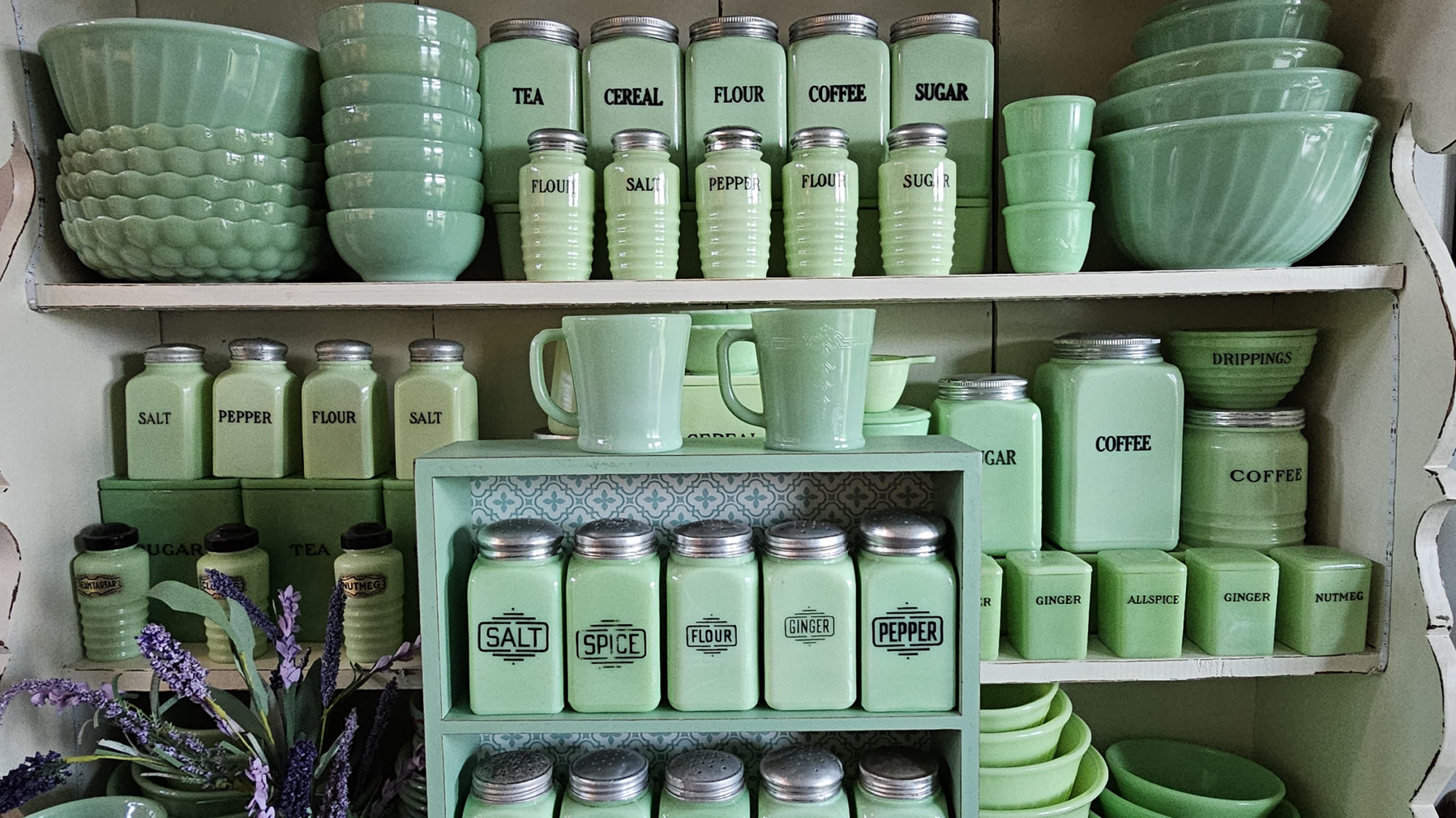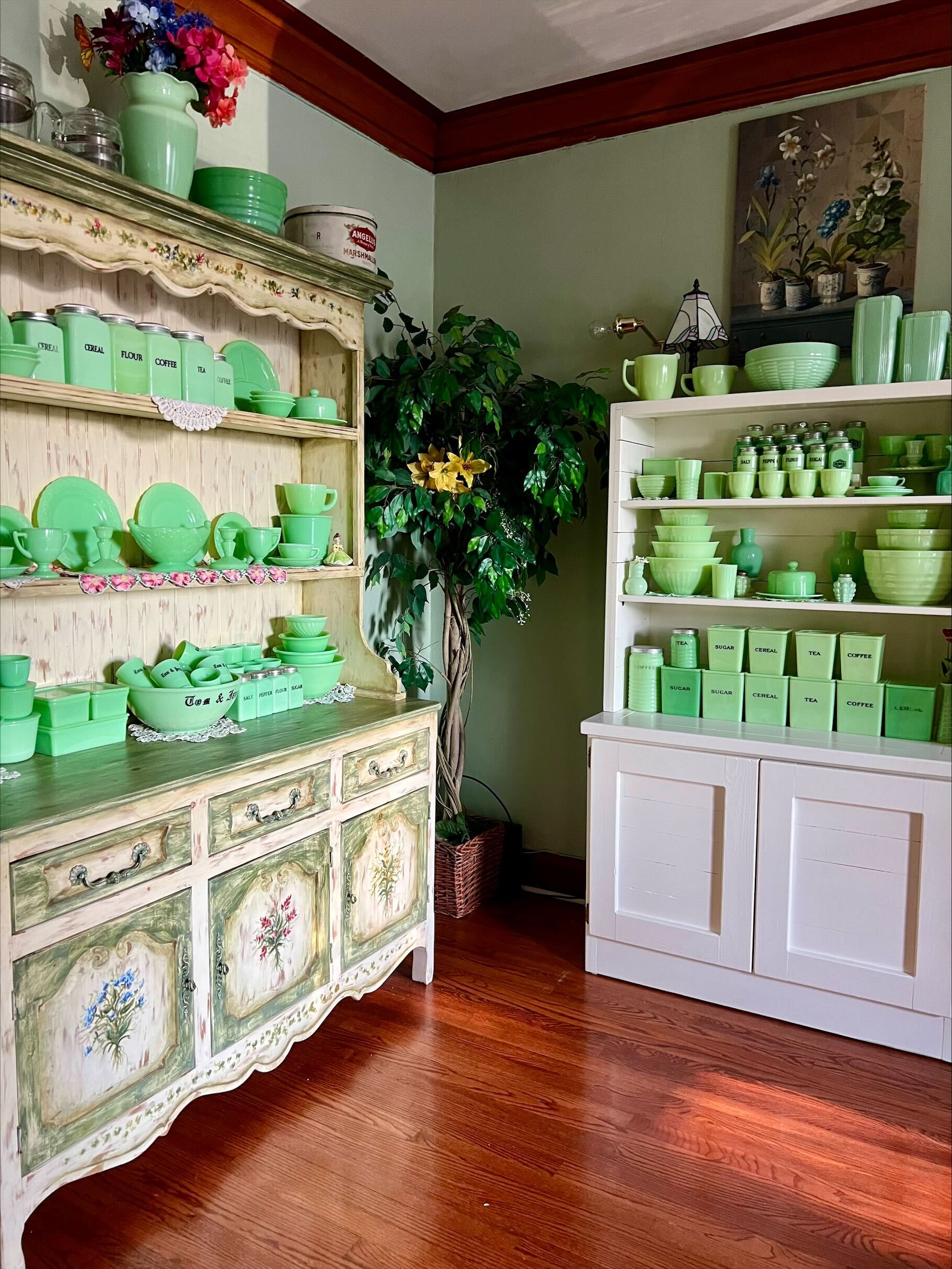
The iconic green thrift store staple is now a cult collectable with a price tag to match
In 2009, Nick Stein took up an unusual hobby for a college sophomore: collecting vintage jadeite dishes. He had noticed Martha Stewart using vintage jadeite plates under potted plants instead of standard terracotta saucers in her eponymous magazine and thought, “That’s such a classy way of doing it.” Stein started doing some research on the eBay jadeite landscape and picking up a few cheap pieces of the milky mint green glass at his local thrift store.
“At the time, it was kind of easy to do that,” he tells me. “Of course, now it’s impossible.” Fifteen years of HGTV home improvement shows and social media later, jadeite has evolved from a folksy thrift store novelty into an in-demand decor item. There are multiple Facebook groups dedicated to collecting it (Jadite Junkies is the biggest, with more than 16,000 members, but there’s also Jadeite Collectors, Jadeite Fanatics, The Original Jadeite Collectors Group, and American Jadeite, to name a few).
On Instagram and TikTok, it is routine for collectors to share photos and videos of their jadeite display cabinets dressed up for Christmas, Easter, and Halloween. In Tokyo, you can sidle up to a counter flanked by a floor-to-ceiling jadeite display to eat matcha waffles off of jadeite plates at a café dedicated to Fire-King dishware (the all-American jadeite brand that is now exclusively produced in Japan). It’s even a centerpiece on Chappell Roan’s dining room table.
Before it was a collectible item, jadeite was a cheap, utilitarian material for household items. In the 1930s and ’40s in the United States, companies like McKee, Jeannette Glass, and Anchor Hocking (under the brand Fire-King) started producing sturdy glass dishes, mugs, canisters, and other housewares in a jade-like opaque mint green color. “People thought of it as just kind of junk,” says Stein. The dishes were sold at hardware stores and five-and-dimes or given away as special promotions with everyday grocery items.
Almost a century later, when one can buy mass-manufactured glassware in any color under the sun with a click and a few bucks, jadeite is having a second life as an extravagant collectible. I’ve spotted thrift store finds from my own collection on eBay for sale in the triple digits. Laurie Rued, a collector from North Carolina with about 1,000 pieces in her collection, says she still regrets not buying a McKee column sugar canister a little over a decade ago when she had first started collecting and spotted one for $75. “It’s actually worth more than $1,000 now,” she tells me. Lucia Reyes, a Chicago-based collector, says that “the prices have skyrocketed” since she started collecting just a couple years ago.

Photo by Lucia Reyes
While there are a finite number of pieces to collect from the 1930s and ’40s, several companies have stepped in to capitalize on the renewed interest. Mosser, an Ohio-based company that was founded in 1971, still makes its ubiquitous jadeite cake stands. Martha Stewart started selling her own jadeite kitchenwares in the late ’90s via mail-order catalogs and still sells them today via Wayfair, JCPenney, and Target. In 2000, Anchor Hocking reissued a series of its original Fire-King designs, and in 2010, Fire-King Japan opened up shop and became the exclusive manufacturer of Fire-King products (combining the traditional glass manufacturing method with Japanese techniques like Hidehira lacquerware)
In recent years, Cracker Barrel, Ree Drummond (The Pioneer Woman), and Joanna Gaines have all gotten into the game of selling newly manufactured kitchenwares made from the minty material. In a strange combination of the United States’ rapidly gentrifying marijuana culture and our nostalgia for mid-century Americana, Food52 is now selling a $160 jadeite one-hitter.
Hard-core collectors have mixed feelings about these newer designs and reproductions (sometimes referred to as “fake jadeite” or “fantasy jadeite” in the community). Some jadeite Facebook groups even limit discussion and sales to original American-made products from the three core brands of McKee, Jeannette, and Fire-King.
“The quality is simply not as good,” says Reyes of the newer products. For some collectors, like Reyes, the connection to historic production processes is part of the appeal—for instance, the fact that many pre–World War II pieces of jadeite were made with small (and allegedly safe) amounts of uranium to enhance the color, making them glow an eerie neon color under a black light. Although every brand (including the modern ones) has a slightly different formula, and although some collectors claim that original stock has a certain feel and weight to it, most jadeite pieces are made from roughly the same indistinguishable shade of green, heat-proof glass. Some of the new-school products have even become collectibles in their own right, like a ’90s-era Martha Stewart feather bowl that now goes for more than $300.
Courtney Vettel, who started collecting jadeite as a teenager and now owns more than 1,000 pieces, finds plenty of room for reproductions in her collection. “I love the price point and often use their pieces in my everyday kitchen,” she tells me. “I typically save my vintage jadeite for holidays and special occasions.”
Stein, now an earthquake researcher at University of California, Berkeley, has about 650 pieces of his own (given his profession and location in the Bay Area, his collection is fully insured and stored to survive earthquakes). He’s heard arguments that newer pieces would confuse buyers and lower the value of originals. “I know a lot of people, especially in the antiques market specifically, who resent that stuff because it changes the way people see the jadeite collection as a whole,” he tells me. Although he doesn’t collect much new-school jadeite, he has no problem with people who do.
“I like that it’s keeping the interest in it alive,” he tells me. “It’s not been a trend that’s waned over time.”
Beyond jadeite’s aesthetics, Stein thinks there’s an enduring appeal to collecting the historic stuff. “There’s a limited number of pieces that you can get from the old stuff that was made. So in theory, you actually could get it all,” he says. “It’s a little crazy because some of it is so rare, but it was that treasure hunt aspect, I would say, that really got me into it. And I don’t know about most collectors, but I actually use it. I mean, I use it every day.”
In recent years, Cracker Barrel, Ree Drummond (The Pioneer Woman), and Joanna Gaines have all gotten into the game.
If there’s one person who’s most responsible for the growing interest in (and rising prices of) the jadeite market over the last half-century, it’s probably Martha Stewart, who multiple collectors cited to me as the reason they got started. Influenced by her daughter, Alexis, who began collecting jadeite on a cross-country road trip in the ’90s, Stewart started her own stockpile of the glassware, which began making cameos on her TV show and in the pages of Martha Stewart Living. By collecting a large inventory over the last three decades, Stewart was able to market her own reproduction line of jadeite while effectively driving up the value of the originals. When she sold off part of her collection in 2022 at a tag sale, she reported that Blake Lively and Kris Jenner cleaned up shop, with Jenner even flying in an assistant to obtain a specific rare piece.
Although anyone can start a jadeite collection today with an investment of about $15 to spend on a small plate or bowl, almost every serious collector has that holy grail that they would consider emptying their bank account or flying across the country for. For Reyes, it’s the Jeannette salt box, and for her husband, it’s a McKee vinegar cruet. For Vettel, it’s a Jeannette spice canister for cloves. “I missed out on one a few years ago on eBay, and it still haunts me,” she tells me.
For Stein, it’s a large rectangular pitcher with a lid and a handle made by Jeannette. Because glass lids break or go missing so easily, it’s rare to find any of these lidded canisters, boxes, and pitchers completely intact, so Stein has had to come to terms with the fact that he may never get his hands on his dream piece.
“They’re very slippery, so a lot of that stuff just did not survive, and it’s becoming rarer by the day,” he says. Collectors buying and shipping pieces across the country isn’t helping.
“People don’t package stuff very well, and then it gets broken and it’s gone forever. Those old things can never be remade, and so it’s always dwindling,” says Stein. “The supply is always getting smaller.”